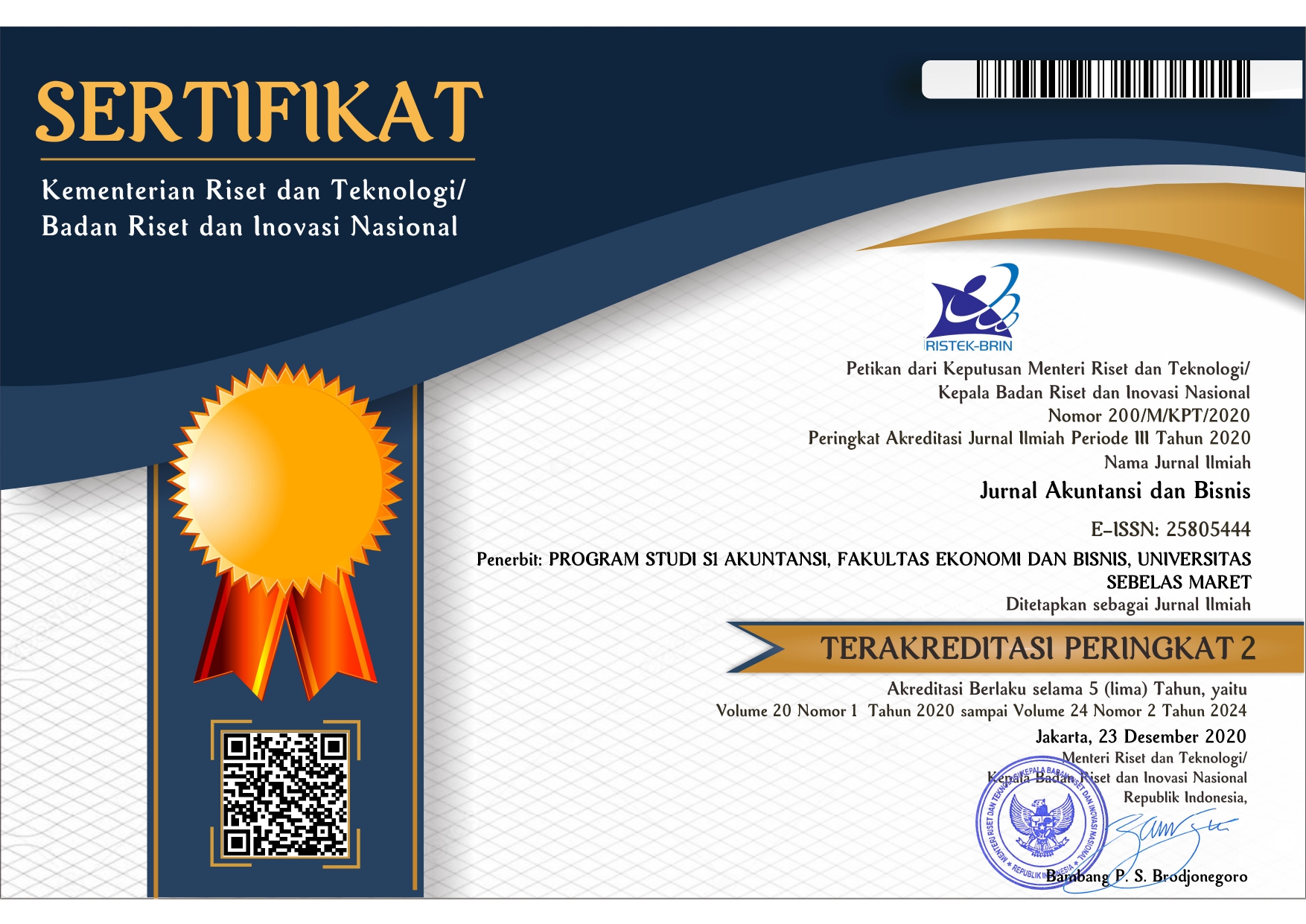The Influence of Firm Age on Profitability Performance of Indonesian Manufacturing Companies with The Age Level of Directors as Moderating Variable
##article.abstract##
Penelitian ini secara empiris menyelidiki pengaruh dari tingkat usia anggota Dewan Direksi (BD) sebagai variable moderasi pada pengaruh dari usia perusahaan terhadap kinerja keuangan perusahaan manufaktur yang terdaftar di Bursa Efek Indonesia (BEI). Data sekunder yang dikumpulkan dari 125 laporan keuangan tahunan perusahaan manufaktur dengan periode tahun 2014 hingga 2017 digunakan sebagai data panel yang menjadi sampel penelitian dan analisis regresi diterapkan pada model penelitian dalam studi ini. Hasil analisis pada studi ini menunjukkan bahwa usia perusahaan terbukti memiliki pengaruh positif secara langsung yang signifikan terhadap kinerja keuangan perusahaan yang diukur dengan rasio profitabilitas berbasis akuntansi, yang meliputi ROA, ROE, dan NPM. Namun intensitas pengaruh dari tingkat usia perusahaan terhadap kinerja profitabilitas perusahaan yang diukur dengan ROE secara signifikan bergantung pada pengaruh dari tingkat usia anggota BD sebagai variabel moderasi. Semakin tinggi tingkat usia anggota BD dapat memperlemah pengaruh dari usia perusahaan terhadap ROE, namun Semakin rendah tingkat usia anggota BD dapat memperkuat pengaruh dari usia perusahaan terhadap ROE. Selain itu, tingkat usia anggota BD juga memiliki pengaruh negative secara langsung yang signifikan terhadap ROA dan ROE. Dengan demikian, tingkat usia anggota BD dapat dianggap sebagai Moderator Semu. Penemuan dari penelitian ini turut berkontribusi pada studi tata kelola perusahaan mengenai usia pemimpin perusahaan dengan menguraikan adanya pengaruh secara tidak langsung dari tingkat usia anggota BD pada pengaruh usia perusahaan terhadap kinerja keuangan perusahaan dalam konteks negara dengan kondisi ekonomi yang masih berkembang, Indonesia.
##article.subject##
Full Text:
PDFReferences
Ali, M., & Konrad, A. (2017). Antecedents and consequences of diversity and equality management systems: The importance of gender diversity in the TMT and lower to middle management. European Management Journal, 35(4), 440-453. https://doi.org/10.1016/j.emj.2017.02.002
Assenga, M., Aly, D., & Hussainey, K. (2018). The impact of board characteristics on the financial performance of Tanzanian firms. Corporate Governance: The International Journal Of Business In Society, 18(6), 1089-1106. https://doi.org/10.1108/cg-09-2016-0174
Azaria, D., Murhadi, W. R., & Silvia Sutedjo, B. (2021). Board diversity and financial performance in Indonesia. Journal of Entrepreneurship & Business, 2(2), 86–95. https://doi.org/10.24123/jeb.v2i2.4537
Chams, N., García-Blandón, J., & Hassan, K. (2021). Role Reversal! Financial Performance as an Antecedent of ESG: The Moderating Effect of Total Quality Management. Sustainability, 13(13), 7026. https://doi.org/10.3390/su13137026
Chong, L., Ong, H., & Tan, S. (2018). Corporate risk-taking and performance in Malaysia: the effect of board composition, political connections and sustainability practices. Corporate Governance: The International Journal Of Business In Society, 18(4), 635-654. https://doi.org/10.1108/cg-05-2017-0095
Darmadi, S. (2013). Do women in top management affect firm performance? Evidence from Indonesia. Corporate Governance: The International Journal Of Business In Society, 13(3), 288-304. https://doi.org/10.1108/cg-12-2010-0096
Delgado-Márquez, L., de Castro, J., & Justo, R. (2017). The boundary conditions of gender diversity in top teams. Management Research: Journal Of The Iberoamerican Academy Of Management, 15(4), 425-442. https://doi.org/10.1108/mrjiam-06-2017-0749
Gordini, N., & Rancati, E. (2017). Gender diversity in the Italian boardroom and firm financial performance. Management Research Review, 40(1), 75-94. https://doi.org/10.1108/mrr-02-2016-0039
Hambrick, D. C., & Mason, P. A. (1984). Upper Echelons: The organization as a reflection of its top managers. Academy of Management Review, 9(2), 193–206.
https://doi.org/10.5465/amr.1984.4277628
Helm, R., & Mark, A. (2010). Analysis and evaluation of moderator effects in regression models: State of art, alternatives and empirical example. Review of Managerial Science, 6(4), 307–332. https://doi.org/10.1007/s11846-010-0057-y
Jadiyappa, N., Jyothi, P., Sireesha, B., & Hickman, L. (2019). CEO gender, firm performance and agency costs: evidence from India. Journal Of Economic Studies, 46(2), 482-495. https://doi.org/10.1108/jes-08-2017-0238
Kagzi, M., & Guha, M. (2018). Board demographic diversity: a review of literature. Journal Of Strategy And Management, 11(1), 33-51. https://doi.org/10.1108/jsma-01-2017-0002
Kagzi, M., & Guha, M. (2018). Does board demographic diversity influence firm performance? Evidence from Indian-knowledge intensive firms. Benchmarking: An International Journal, 25(3), 1028-1058. https://doi.org/10.1108/bij-07-2017-0203
Kılıç, M., & Kuzey, C. (2016). The effect of board gender diversity on firm performance: evidence from Turkey. Gender In Management: An International Journal, 31(7), 434-455. https://doi.org/10.1108/gm-10-2015-0088
Kartiningsih, D., & Daryanto, W. M. (2020). The effect of firm characteristics to profitability of food and beverage companies listed in Indonesia stock exchange. International Journal of Business, Economics and Law, 22(1), 69-76. ISSN 2289-1552
McGuire, J., & Taylor, E. (2017). Board of director and committee diversity and firm Financial Performance. Academy of Management Proceedings, 2017(1), 14207. https://doi.org/10.5465/ambpp.2017.14207abstract
Naseem, M., Lin, J., Rehman, R., Ahmad, M., & Ali, R. (2020). Does capital structure mediate the link between CEO characteristics and firm performance?. Management Decision, 58(1), 164-181. https://doi.org/10.1108/md-05-2018-0594
Nurlaela, S., Mursito, B., Kustiyah, E., Istiqomah, I., & Hartono, S. (2019). Asset Turnover, Capital Structure and Financial Performance Consumption Industry Company in Indonesia Stock Exchange. International Journal Of Economics And Financial Issues, 9(3), 297-301. https://doi.org/10.32479/ijefi.8185
Policies to Support the Development of Indonesia’s Manufacturing Sector during 2020–2024: A Joint ADB–BAPPENAS Report. Asian Development Bank. (2021). Retrieved 20 September 2021, from http://dx.doi.org/10.22617/TCS199910-2
Shrestha, N. (2020). Detecting Multicollinearity in Regression Analysis. American Journal Of Applied Mathematics And Statistics, 8(2), 39-42. https://doi.org/10.12691/ajams-8-2-1
Solakoglu, M., & Demir, N. (2016). The role of firm characteristics on the relationship between gender diversity and firm performance. Management Decision, 54(6), 1407-1419. https://doi.org/10.1108/md-02-2015-0075
Tanikawa, T., Kim, S., & Jung, Y. (2017). Top management team diversity and firm performance: Exploring a function of age. Team Performance Management: An International Journal, 23(3/4), 156–170. https://doi.org/10.1108/tpm-06-2016-0027
Zulfikar, R., Lukviarman, N., Suhardjanto, D., Ismail, T., Dwi Astuti, K., & Meutia, M. (2020). Corporate Governance Compliance in Banking Industry: The Role of the Board. Journal of Open Innovation: Technology, Market, and Complexity, 6(4), 137. https://doi.org/10.3390/joitmc6040137
DOI: http://dx.doi.org/10.20961/jab.v22i2.844
Jurnal Akuntansi dan Bisnis (JAB)
ISSN 1412-0852 (print), 2580-5444 (online)
Published by Accounting Study Program, Faculty of Economics and Business, Universitas Sebelas Maret, Indonesia

JAB on http://jab.fe.uns.ac.id/index.php/jab is licensed under a Creative Commons Attribution-ShareAlike 4.0 International License










